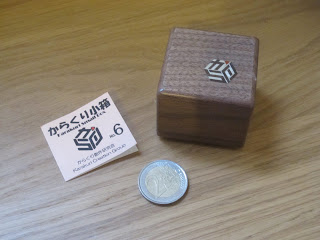In the past I never really had any luck solving '2D Sequential Movement' type puzzles, so I tended to stay away from them. Recently however I saw this as a bit of a shame, so decided to give them another chance. This time I had much more success!
I thought I'd write about these two puzzles specifically as they are some of the most well known puzzles from the genre. And the reason I'm writing about them together is because they are different takes on what is essentially the same puzzle.
The puzzle consists of two intersecting rings which are made up of 38 balls in four different colours. The picture on the left shows it in the solved state.
The balls can be scrambled by rotating the balls in their ring shaped tracks, balls can then be moved from one position to another at either of the two intersecting points where the two rings come together.
I was actually quite impressed with myself when I managed to get all of the balls in the right place apart from four which needed to swap places. However I was stuck at this step for another couple of days! The real challenge of this puzzle comes from moving the last balls into their correct positions.
After a couple of days I worked out a system to solve the last pieces, and was thrilled! Especially considering how miserably I failed the first time I tried this type of puzzle.

This other puzzle is a variation on the theme of the Hungarian Rings, and these were made by Rubik's under the name of Rubik's Rings, made in 1999 by a company called OddzOn. I don't think anywhere actually sells this puzzle any more, so I found my copy on eBay.
As you can see it is essentially the same as the Hungarian Rings, except with a couple of glaring differences;
Firstly the puzzle isn't flat, it's skewed at the intersections. This doesn't affect how the puzzle works, it just makes it look a bit funkier.
Secondly there are only three colours of balls
rather than four. And lastly, there are only 34 balls as opposed to 38.
Because of the lower number of balls and less colours I found this one to be easier to get to an 'almost solved' state than the Hungarian Rings. Then the final moves can be done in the same way as the first puzzle.
 The only problem I found with this puzzle is that OddzOn built in a ratcheting type mechanism to hold the balls more precisely, presumably to stop the balls from misaligning at the junctions and jamming, although I kind of found that this seems to do the exact opposite. I really had to line each ring up exactly in order to spin them round. Not great if you fancy going for a quick solve time.
The only problem I found with this puzzle is that OddzOn built in a ratcheting type mechanism to hold the balls more precisely, presumably to stop the balls from misaligning at the junctions and jamming, although I kind of found that this seems to do the exact opposite. I really had to line each ring up exactly in order to spin them round. Not great if you fancy going for a quick solve time.
So I'm glad I decided to give this genre of puzzle another try. I think I just didn't try hard enough to solve them the first time round, but honestly, with a bit of thought and determination I reckon anyone could solve these two puzzles in a reasonable amount of time.
The Hungarian Rings are available from Puzzle Master, however like I said the Rubik's Rings aren't (as far as I'm aware) commercially available any more, so keep an eye out on eBay as I think they come up pretty regularly.





















